American Sabbatical 040: 10/26/96
Arcata
10/26.. Arcata.
We’ve given Eureka/Arcata the full treatment and they’ve survived the scrutiny. Neither of them suffers from
an excess of charm. Set down in the flats around Humbolt Bay,
they are mostly ticky-tak California stucco bungalows, cheek-to-jowl.
There are a smattering of eyesome Victorian survivals near the
town centers, and one finger-pointing mansion, the William Carson
House, in Eureka. Carson was a lumber baron who built this gaudy
pile of turreted gingerbread in the last century. Now it’s a men’s
club, with the biggest palm tree in the county out front. The
palms shiver at night up here, but it wouldn’t be California without
them.. wretched stunted things at this latitude.
| Just as the lumber baron’s castle lords it over the bungalows,
timber towers over the town.. literally and figuratively. This
is redwood country, and the mills dominate the view and the economy.
Humbolt is a dumbell-shaped bay enclosed by a long finger of sand
poking down from the north. Eureka sits on the south end, near
the bay's mouth, Arcata is on the landward side to the north,
and the towns of Manila and Samoa straggle along the spit to seaward.
The big mills are in Samoa, and fill the seaward view from Eureka. |
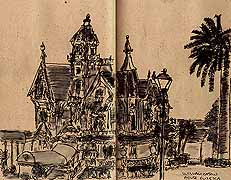
Carson House
(Bryce)
|
Only one of the two pulp mills is now running. When state environmental
enforcement forced the industry to address clean water issues,
followed shortly by a crash in pulp prices, one mill shut its
doors. The other, Louisiana Pacific, converted to oxidation processing
and rode out the slump by selling pulp to the Germans, who have
a ban on chlorinated product. Of course LP now brags about its
environmentalism. A couple of giant sawmills and immense pulp
ships at the dock round out the skyline.
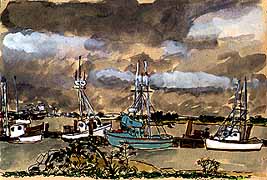
Trawlers
(Bryce)
|
Inside the bay two marinas are stuffed full of trawlers and yachts.
Nobody was venturing outside during our stay. The "winter" storm
that’s been precipping on us has set the salt to tumbling, and
the bay entrance is a nightmare of rolling surf, galloping between
mile-long jetties, breaking high onto gawking strollers. |
So the fishermen were ashore to turn out in force for a public
protest of the new Coho regs. And get this: they were complaining
that the regs weren’t strong enough. As an election-year fudge
the state pols were postponing implementation of landuse standards
designed to protect spawning habitat. On this one the timber industry
and the fishermen are head to head. Funny to see Green fishermen.
The salmon fishery is gasping for breath here (although groundfishing
is very healthy, they say), and the perceived problem is habitat
destruction. The small logging operators are willing to conform
to the new rules, which they generally do already, but the big
shows have no interest in cleaning up their act. Hence the smell
of fudge. As in Maine, you know who pays the political bills.
Just as in Maine’s paper plantation, timber is the name of the
game here. After the initial gold fever was sweated out of these
hills.. TIMBER! And logging is still the foundation resource of
the Humbolt County economy. The same rules apply, East or West.
Consolidation has swallowed the small mills, automation and clearcutting
have reduced unit costs, and the corporate giants are logging
faster than replacement to maximize profits. Most of the logging
is on public land, of course. You’ve heard the tale. This is spotted
owl country. One side will tell you it’s all about jobs, prices
and the economy. The other decries the devastation of the environment.
Clinton calls for compromise and comes down right of center.
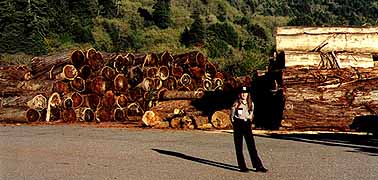
Logging Cop
Meanwhile the fishermen in Eureka are protesting that the big
loggers are bad actors in the woods. Reporters like David say
it’s because they are cutting beyond replacement that the oldgrowth
is under the ax. Not to mention the questions of replanting and
monocropping. The loggers are replanting their private land, but
the national forest? And it’s all clearcut, herbicide, single-specie
planting. We’re headed into the big woods today, and will report.
Back in town, Eureka, for all its renovated core of tourist shoppes,
is still a seedy milltown. The good old days when logging was
a monastic enterprise and the camp bosses would send their gangs
into town for a Saturday shambles are long gone. The redlight
district is now scrubbed and quainted-up. Except for one holdout,
Jimmy Dunn’s, which David insisted I buy him a drink in. Even
the beer tasted dusty, and the clientele looked stuffed and mounted.
Ah yes, the good old days. The result of which is still visible
out back. Homeless vagabonds are much in evidence along the coast
as they shuttle back and forth with the weather, avoiding the
heat. Eureka even removed park benches downtown to keep them moving.
Paradise has its underside, even in Eureka.
Arcata is a different kettle of fish. It feels as though the 60s
came to visit here and never left. Backing up from the bay marshes
into the hills, Arcata has pushed liberal enlightenment all the
way into the redwoods. Humbolt U. rears its mock Spanish edifices
on the brow of town, and its undergrads, mostly specializing in
environmental sciences, long since took over local electoral politics.
There is a municipal grove of secondgrowth redwoods (only 150
feet tall), full of beaded and feathered tribespersons drumcircling
and rocknrolling on a sunny Saturday. And a municipal marsh, full
of birds and birders.
| The marsh is one of those environmental success stories we should
be hearing more about. When the cleanwater laws began to bite
home, Arcata had to address the issue of waste treatment. Between
the mills and the municipalities, the bay was an open sewer. The
traditional solution would have been to build a big treatment
plant, run pipes into the foothills, and encourage development
to pay for it. The college longhairs quashed that. Let’s cleanup
the marshes! was the cry. |
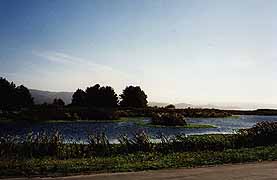
Sewage Plant(s)
|
So they did, converting abandoned factory sites and landfills
back into functioning wetland, with a series of ponds for organic
secondary and tertiary waste treatment. We drove around the ponds,
watching harriers and peregrines diving on avocets and egrets,
while on the bayside wetsuited windsurfers zipped along in the
half gale still blowing.. and THE SUN had come out. That California
sun. We're still steaming.
Downtown Arcata is the California funky you always imagined. Especially
on market day, when the town square is full of vendors, trustifarians,
reefersmoke, drumming and doodah.. all looked down on magnanimously
by a bronze William McKinley. Great bookstores. Great music stores.
And a food co-op to make your mouth water. This institution is
the size of our local chain supermarket, jammed with fresh produce,
exotic (to us) organics, alternate medicines, poultry, meats,
seafood, the works (not without much political agonizing over
PC products, we’re told). And it’s the local bulletin board, soapbox,
and hey Charlie how are you?
Enclosing the bay, between the marsh and LP, runs the long sandspit
that is Manila and Samoa. David says these are the last dogpatch
towns on the California coast and they are as down-at-heel as
you could desire, minuscule bungalows, trailers, and shanties,
dug into the sand dunes with all ten fingers. David owns a tiny
bungalow in Manila which he sublets gratis to one of his leading
ladies, with husband and son. It is totally hidden behind the
plantings, mostly Christmas trees of years past. His neighbors
are more taken with lawn ornamentation and junk cars (if you can
distinguish). David says it’s the sort of town where your affluence
is measured by how many parts cars there are in the yard. So far
these seedy paradises have resisted upscale development. Dogpatch
may be the only defense against suburbanization.
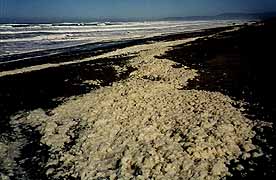
Manila Foam
|
We walked the long beach outside Manila in the half-gale, with
windrows of jiggling foam up to our ankles, and pippets scuttling
along the surfline, dodging sneakers. These are the periodic megawaves
that rush up the beach and engulf the unwary. This ocean may be
pacific out on the deepwater waves, which are longer and farther
apart than on the Atlantic, because of their tremendous fetch
(Atlantic seas are shorter and steeper by comparison, hence nastier
in a small vessel) but once the seas start humping up on the shoaling
shore there’s nothing pacific about them. And the littoral seems
to incline less abruptly here, so the long-frequency waves begin
rolling over way out, and break and boil forever. Surf City. But
you better wear your drysuit. The Aleutian Current washes this
coast, and it’s bonenumbing. |
Humbolt County, these settlements around the bay, retain a sense
of isolation from the larger California, and will tell you so
with pride. The roads in often are cut by the weather. We remembered
that plowtruck pushing landslide debris off the pavement along
the Klamath. And there are numerous places where obvious washouts
have been patched on both coast roads, as well. It’s an enclave
full of exiles from the faster lane, and the later age. Like Maine
it has its own local theater, and like Maine theater, David’s
troupe has suffered economic setbacks in recent years.
Starting in the 70’s, these players performed in a defunct dairy
in Arcata, slowly transforming the building into a functioning
theater. But the owner kept jacking the rent while the grant money
ebbed, until two years ago the troupe had to fold its tent and
creep away. Is this a familiar tale? Arts institutions suffering
from an edifice complex? But they were still $2000 in the hole
to local merchants, and determined to pay it back. So this year
they reformed as a homeless troupe, and are attempting to draw
audiences to instant theaters, thither and yon. Small cast, minimal
scenery, low overhead.
We arrived at a defunct middle school in Manila, and were ushered
into the old cafeteria to sit in portable seating. It had all
the ambiance of the community shows in the Magdalens.. even to
the crashing surf. We were ready to suffer through another hideous
downhome performance. Instead we were riveted by as professional
a rendition of A Walk In The Woods as we might have seen on Broadway.
David’s room-mate Tom was the Russian diplomat, and his comic
timing was immaculate. In an instant we were transported from
seedy Manila to the Swiss woods, and into the magic realm of theater.
When its good, like this, there is nothing to compare with the
live stage.
We spent the following evening with a crowd of thespians, and
had the riotous good time you might expect. These are folks who
have to act, but who’ll never try to make it on the Great White
Way. Smalltown (or minicity) actors, who are CW DJs, or local
reporters, or whatever pays the bills in their other lives, but
who are transformed under the lights, and who transform us. Good
show.
But the best show of Humbolt County was waiting for us just up
the coast. David had choreographed his tour de Humbolt. From Jimmy
Dunn’s and the phantasmagoric naive yardart of Gabriel Romano,
now behind glass in downtown Eureka, to the mills and ambiance
of Manila, through the hippidom of Arcata, to the grandeur of
the northern coast. We ambled along in his van, drifting through
stopsigns, halting in midpavement for a vista, or an anecdote,
running up over the curbing, where there was any. David drives
as he is, large and shambling, and declaims nonstop. All you can
do is sit back and enjoy.
He took us along the old coast stagecoach route, a treacherous
bit of precipicity through secondgrowth redwoods, looking down
onto foamgirt seastacks and hazy sands, to the smallest city in
CA, Trinity. Whose other superlative claim is being the oldest
continuously settled site in North America, its local tribe having
been perched there since 5 or 600 AD. Ah, local pride. Now it
has the requisite native casino, fish pier, and seafood house.
We were all toting binoculars, as David is an avid birder, and
most of our sudden halts were to check out avian visitations.
I can’t recite all the feathers he identified for us, but it changes
the landscape when you are sorting it for flutters and flits.
Pelicans, and bald eagles, big ravens, California quail, rufus
this and tufted that, curlews, and redtails, it’s easy to share
in someone’s eager enthusiasm. The psychic imbalance between our
500 pound friend and these light-than-air actors makes our hearts
lift off, too.
But birds weren’t the only show. First it was down to a small
cove to see sea-lions cavorting on a ledge. Then it was out to
Patrick’s Point to spot for whales.. we saw three gray whales
spouting along, on their way south. Even at 300 yards it buoys
you up to watch the big fish blow and roll. (At the point there
was also a reconstructed Indian village. Hunched, half-submerged
buildings of redwood planks and posts tied together with roots.
Very much part of the landscape, with fourfoot circular entrances
you had to crawl through, and slatted roofs for light and smoke.)
After whales it was elk, and we admired two herds of Roosevelt
elk (protected since near-extinction in the 20’s) browsing in
meadows by the highway. But the elk weren’t the crowning touch.
| We had been driving through newgrowth redwoods, with an occasional
monster tree spiking out of the canopy, or standing swollen in
the rainforest gloom. Now we went up into the great groves. Climbing
1000 feet from the shore we were lifted into the Ladybird Johnson
Memorial Grove, where Peggy and I took the ultimate walk in the
woods. The majestic stillness and overpowering solemnity of this
oldgrowth forest leaves you utterly silent. All the human noise
drains away. Peggy actually burst into tears touching a venerable
leviathan. Vegetables 250-300 feet tall, their shattered tops
disappearing into the sky behind their dainty foliage, which only
spreads out an hundred or more feet above the undergrowth. The
only other visitor to this grand cathedral was a large raven who
laughed at us mere mortals, so far below. We came down to earth
chastened and speechless. For a spell. |
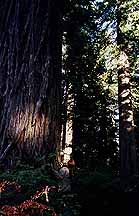
Tree Hugger
|
(Memo #3)
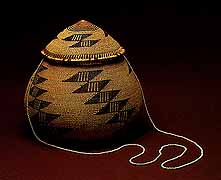
Karok Basket
(James Toms Picture)
|
Oct. 27 - Yurok, Karok, Hupa
Who? First People of northern California
What? reconstructed village and museum displays
Where? both coastal and inland settlements
When? thousands of years ago to today
How? adapted to variety of environments
Topics: First nations/Native Americans of California, adaptations/relations
between Anglos and First Peoples in California.
Questions: Why do our popular images of First People/Native Americans
exclude the people of California? |
Yurok, Karok, Hupa, Miwok, Chumash, Yana, Maidu, Achumawi. These
are some of the 500 different groups of First People that existed
in California before white contact. They are much less known than
the Plains or Eastern Woodlands cultures who have been portrayed
often in Hollywood melodramas. The California Indians did not
raise corn or hunt buffalo. Coastal groups in California relied
on marine mammals and shellfish, inland groups depended greatly
on acorns and - perhaps - pine nuts. I have wanted to know more
about the California groups since I heard of them from a college
Archaeology professor.
| We have no romantic images of Indians grinding nuts for acorn
soup. Longfellow didn’t utilize Miwok mythology. No major oil
painters seem to have depicted the First Peoples of California,
although Edward Curtis made wonderful photographs of the California
peoples at the turn of the century. Ishi was perhaps the most
wellknown California native. The last of his people, Ishi spent
his later life at the anthropology museum at Berkeley, early in
the century. The First Peoples of California were contacted early
by Spanish and Russian ships. Potatoes gotten through contact
were grown quite early by some groups. Some south California First
People were collected into Catholic missions. Americans streamed
into California during the Gold Rush. After this, there seem to
have been numerous violent actions by Americans against the native
peoples. In the massacre at Indian Island off Eureka, Americans
attacked a group that had gathered for a religious dance. |
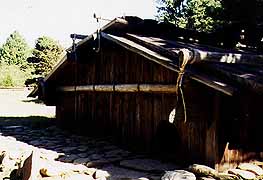
Yurok House
|
In northwestern California, we encountered the First Peoples in
a number of ways: we drove through the Hoopa Valley Indian Reservation
and the Sumej township, we visited the Clarke Museum in Eureka,
and walked through a reconstructed Yurok village. The first two
visits gave us glimpses of First Peoples of California today,
who drive pickups and live in ranch houses and bungalows, wear
Nikes and jeans or suits and ties. We saw no pre-European housing
or traditional costumes in use on the reservations or in towns.
There was little visible to indicate that the residents were First
Peoples.
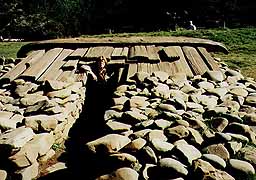
Entrance to Sweat Lodge
|
Our reporter friend said California peoples are less known because
they had far less spectacular material culture than First Peoples
elsewhere, and worked in wood, shell, hides and plant fibers.
The craft that makes them famous to Anthropologists is basketry.
The Clarke Museum of Eureka boasts that it has “the biggest basketry
collection in the world” filling cases and cases. Baskets were
used by the California First Peoples for fishing, trapping, storing,
carrying, ornamenting, cooking. The people wore small basketry
caps, carried their babies in basketry cradles, used basketry
eel traps, and cooked in baskets (by dropping hot rocks into mush).
The baskets come in all shapes and sizes.They are all twined,
in simple colors, with designs that have names like shark’s tooth,
friendship, and whirlwind patterns. The women worked with a variety
of plants - hazelwood and willow, alder and grape, spruce and
pine. |
The museum had other items - a redwood canoe, stone tools, shell
jewelry (long chains of dentalia). There were photographs of the
flower dance (a female puberty rite), the white deerskin dance,
the jump dance, the world renewal ceremony. Some of these are
apparently still practiced. A mannequin showed the Pre-Columbian
female dress complete with chin tattoos. Still, the museum gave
a very incomplete picture. The culture was reduced to a series
of objects cases which just didn’t give me the sense of a living
culture. We’ve seen other museums that did.
We came closer to the reality when we visited a reconstructed
(pre-European) Yurok village in the Patrick’s Point National Park.
The setting was wonderful, fields and woods overlooking the ocean.
There were three traditional houses and a sweat lodge. Yurok houses
like those of the coast farther north were made of planks. Visually
they are unlike First People habitations to the east. They are
low square houses (perhaps 20 feet across), semi-subterranean,
reached by a low round doorway. The floor has several levels,
a large central square pit area with fire in the middle, then
a higher level around the sides.The roof has a center hole to
let out smoke and a roofing system that let air out under the
eaves as well. The planks are held to great posts with fiber ropes.
The floor was partly stone as well as tamped earth and wood. The
sweatlodge was smaller and lower with stone and wood walls. The
three houses were perhaps thirty feet apart and a quarter of a
mile from the cliff. There were no objects in the houses or sweat
lodge. It was like an empty stage.
| I still don’t have a good sense of the culture of the First Peoples
of California, just an odd jumble of objects and foodstuffs and
rituals and house shapes. Acorns and clams and dentalia. The representation
of California peoples we have seen so far seems to be what anthropologists
scathingly call a “butterfly collection”, the old system of categorizing,
arranging and labeling bits of material culture (or animal species)
in a lifeless way in glass cases (baskets with baskets, monarch
with monarchs ). The more recent approach of museums is to focus
on the people who use the object s and show things in context.
We’ll see other sites and museums associated with the California
First Peoples. I hope we’ll get a sense of functioning societies. |
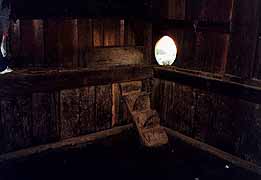
Inside Yurok House
|









